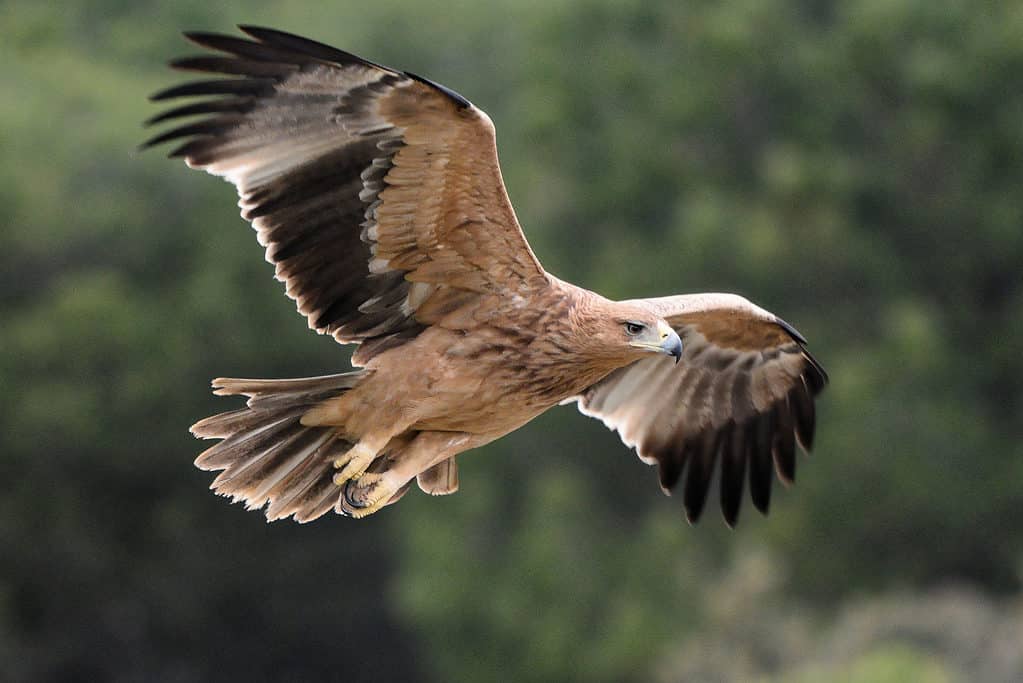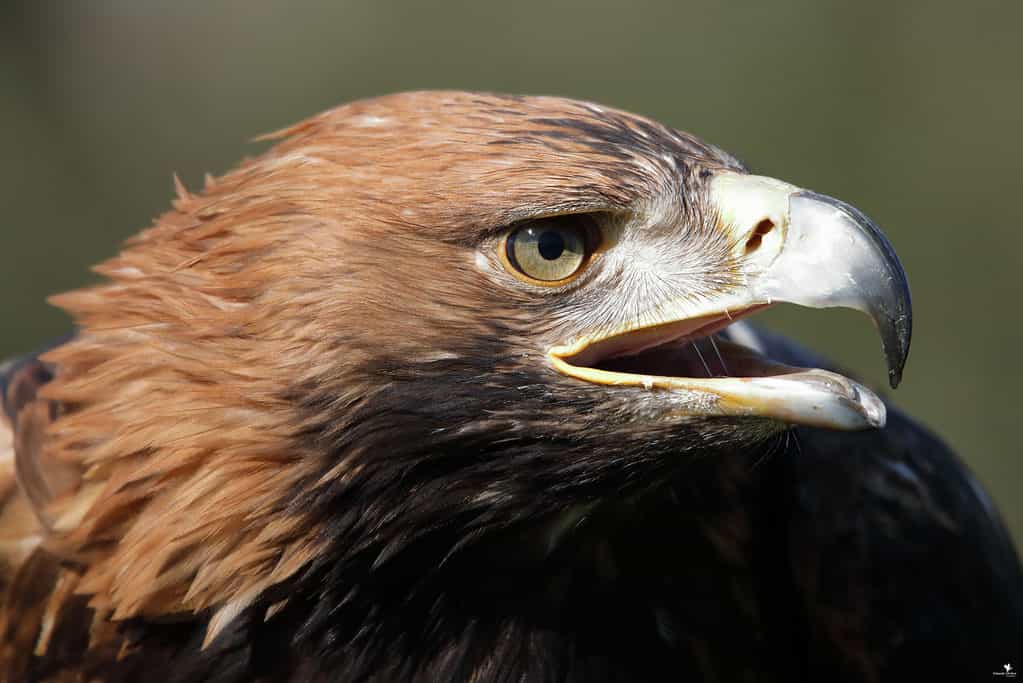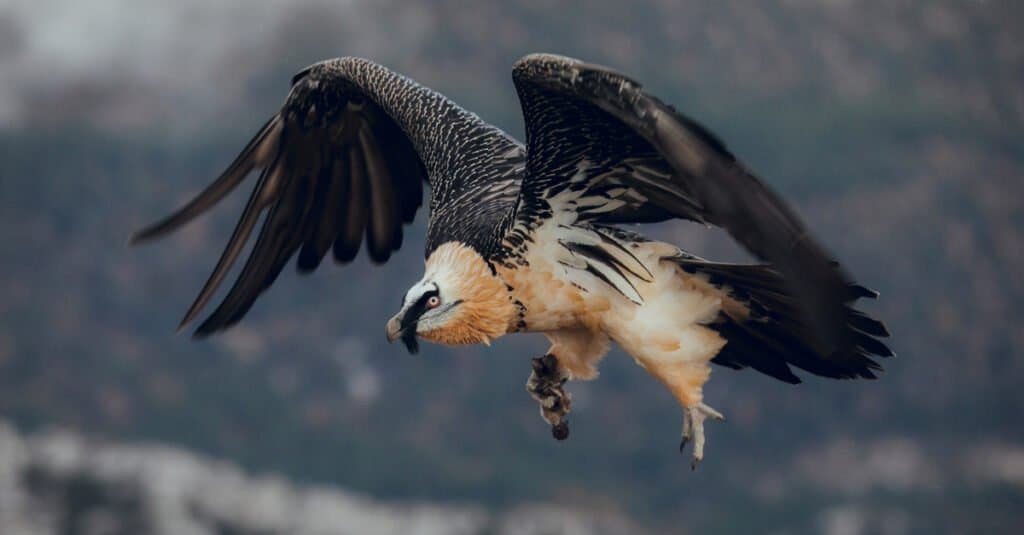Spain has a landscape that includes majestic mountain ranges, coastal marshland and fertile farmland. This variety of landscapes provides habitats for a wide range of species. Located on the Iberian Peninsula it is a popular layover for migrating birds between Europe and Africa. When it comes to choosing a national bird you can imagine there were many worthy candidates. Spain has the highly intelligent magpie, the uniquely patterned Eurasian Jay and the brilliantly beautiful yellow Atlantic canary of the Canary Islands. What bird represents the characteristics of the Spanish people the best? What bird did Spain choose to be their national bird? Read on to find out all about the national bird of Spain.
What is the National Bird of Spain?

Imperial Eagles have a massive wingspan of up to seven feet.
©LABETAA Andre/Shutterstock.com
The national bird of Spain is the imperial eagle. The imperial eagle is also called the Spanish imperial eagle or Adalbert’s eagle. These large eagles represent strength and perseverance. They are similar to the American bald eagle but are a little smaller and do not have the same regal white “bald” head. Imperial eagles have beautiful dark blackish-brown feathers with a mix of lighter brown, almost rust colored, dispersed around their bodies. While bald eagles have a yellow beak and matching yellow feet, the Spanish imperial eagle is noted for the white banding on its shoulders.
Where do Imperial Eagles Live?
Imperial eagles have a limited range with only a few habitats still supporting breeding populations. They can be found in southwest Spain as well as pockets neighboring Portugal. At least 10 pairs of imperial eagles are protected in the Doñana National Park Reserve. The park is located in southwest Spain and provides refuge not only to the imperial eagle but several other threatened species like the Iberian lynx. They make their nests in Quercus suber or pine trees and tend to stay away from human interactions.
How Big are Imperial Eagles?
Imperial eagles are large raptors but they are a bit smaller than the American bald eagle. They have a wingspan of around seven feet so that is pretty impressive. If you stretched your arms out it would be about as wide as you are tall. If you are five feet tall your arm span would be around five feet. Take a second to stretch your arms so you can really relate to just how big these magnificent birds are! If one was sitting next to you on your couch they would stand 28 to 33 inches tall…almost three feet!
Are Imperial Eagles Endangered?
Imperial eagles used to be endangered but due to conservational efforts their numbers have been increasing. At one point in the 1960’s it was believed that there were only 30 pairs left of the imperial eagle. They are still at risk of going extinct due to the low number of their population and limited range, but since 2004 when they were listed as endangered, they have been upgraded by the IUCN to be listed as “Vulnerable”. Their population is not increasing greatly, but is also not showing signs of a significant decrease in numbers either.
What are the Major Threats to the Imperial Eagle?

Imperial eagles were formerly an endangered species but thanks to conservation efforts their numbers have increased and the are now only “vulnerable”.
©Eduardo Medina/Shutterstock.com
The major threats to imperial eagles is food availability, hunters, poisoning, electrocution from power lines and collisions with wind turbines. Conservationists have been successful in having 60% of the population in protected areas now. Multiple agencies have come together in Spain and Portugal to protect these majestic eagles and to insure their populations increase. The Doñana Reserve in southwestern Spain is home to 10 pairs of imperial eagles. The reserve is also protecting the threatened Iberian lynx, which is listed as “Endangered” by the IUCN with a reported 156 lynx remaining at the time of their last assessment in April of 2014.
Is the Imperial Eagle Featured on Spain’s Coat of Arms?
No, the imperial eagle is not on the coat of arms, but there is a crowned lion in one of the sections of the shield. The lion represents the Kingdom of León. The coat of arms also features the Spanish Royal Crown at the top and the Pillars of Hercules which refers to the Strait of Gibraltar that separates Spain from Morocco.
What is the National Animal of Spain?
The national animal of Spain is the bull. The fierce, no-nonsense bull is a strong representative of the people of Spain. Bullfighting has been an integral part of the Spanish history dating back to the 8th century. Every summer the “Running of the Bulls” pits humans vs. bulls as part of the annual San Fermin Festival.
Bulls used in bullfighting are called Spanish Fighting Bulls, or Toro Bravo, which is a cattle breed on the Iberian Peninsula. These bulls can reach weights of 1,300 pounds and have long pointed horns. Similar to how some dog breeds can be more aggressive than others, Spanish Fighting Bulls are also known to be an aggressive breed of cattle.
What other Animals Live in Spain?

Other animals in Spain include the fascinating bearded vulture.
©Aitor Lamadrid Lopez/Shutterstock.com
Other animals in Spain include wild boar, Spanish ibex, alpine marmot, bearded vultures, as well as more common animals like rabbits, deer, squirrels and bats. Along the coasts of Spain you will find a variety of sea turtles, crabs and gulls. Further out in the Atlantic Ocean you might spot a blue-fin whale, bottle-nose dolphins, seals, porpoise and sharks. The Canary Islands and the Balearics have some species that can only be found on these Spanish Islands. Some of the animals you can find on the islands include the Gran Canaria giant lizard (can get to be 32 inches long!), the Tenerife blue finch (the males have beautiful blue feathers) and the blind crab which has no pigmentation and appears all white.
Up Next
- The Flag of Spain: History, Meaning and Symbolism
- The Complete History of Bullfighting
- Top 9 Largest Eagles in the World
The photo featured at the top of this post is © LABETAA Andre/Shutterstock.com
Sources
- Audubon, Available here: https://www.audubon.org/news/day-172-spanish-imperial-eagles
- IUCN Red List, Available here: https://www.iucnredlist.org/species/12520/174111773
- Bird Watching HQ, Available here: https://birdwatchinghq.com/birds-of-spain/
- Donana Reserve, Available here: https://www.donanareservas.com/en/donana/
Thank you for reading! Have some feedback for us? Contact the AZ Animals editorial team.






